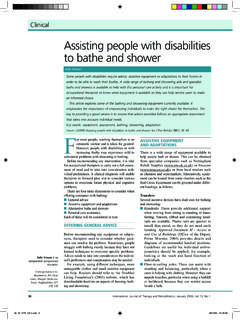Transcription of Beyond Segregated and Exploited - NDRN
1 Beyond Segregated and Exploited Update on the Employment of people with disabilities April 2012. Page | 1. National Disability Rights Network Cover image courtesy APSE: Three employees at Best Buy posing for a photo in the store. Tracy (left), Tracey (middle) and Jai (right). Jai spent his days going from store to store looking for work. He would often stop at Best Buy to recharge his power chair. When Tracey, the assistant manager at Best Buy, noticed Jai using his knowledge of electronics to assist other customers, he offered him a job. Tracy formerly worked in a sheltered workshop but left for competitive employment at Best Buy. Page | 2. National Disability Rights Network A Letter from the Executive Director One year ago we made a call to action in our report Segregated and Exploited : The Failure of the Disability Service System to Provide Quality Work.
2 In that report we examined the ability of sheltered workshops and other Segregated employment settings to meet the needs of workers with disabilities . What we found was a system that does not provide truly meaningful employment opportunities for people with disabilities and in many instances exploits their disability for the financial gain of employers. We found a system that traps these workers in endless training programs that prepare them for nothing and often leaves them impoverished. Worse, federal laws and programs as well as many provider organizations within the disability service system help facilitate this travesty. Our findings galvanized us to take action. Over the last year the National Disability Rights Network and the Protection and Advocacy System that we represent in Washington, DC, have taken action to end Segregated work, the sub-minimum wage, and the further exploitation of workers with disabilities .
3 At the national level, NDRN has worked with lawmakers on Capitol Hill and the Obama Administration on legislation to expand employment options, specifically employment in integrated settings at competitive wages, and to phase out the antiquated and obsolete public policies that lead to sheltered employment and sub-minimum wages. Around the nation, P&As are working at the state and local level assisting workers with disabilities who desire real jobs and helping those trapped in sheltered workshops get out and find integrated employment. P&As are also working systemically to improve and expand employment options at the state and local level so that segregation is no longer the only choice. I am grateful to all those who have joined us in our call to action. They include Self Advocates Becoming Empowered, the New York Association on Independent Living, Page | 3.
4 National Disability Rights Network Community Employment Alliance, Washington State Rehabilitation Council, the Washington State Division of Vocational Rehabilitation, and others. The following update to our report details the work started over the past year and examines further how federal policies are contributing to the segregation and exploitation of workers with disabilities . We are proud of the work that has been accomplished this past year but there is much still to do. Indeed we are only just beginning. Only 20% of people with disabilities are in the workforce with over 400,000 of them stuck in sheltered workshops earning on average only $175 per month. Few receive health care or the other benefits typical of the average American worker. And because of the nature of Segregated work in which workers with disabilities are isolated and hidden away there continues to be instances of exploitation, abuse and neglect.
5 This must end. Now. We can do better and we will. We renew our call to action and pledge to continue challenging a system that is failing to provide quality work to people with disabilities . Curt Decker Executive Director Page | 4. National Disability Rights Network Table of Contents Beyond Segregated & Exploited Update on the Employment of people with disabilities Summary of Activities by the Protection and Advocacy Network on Segregated and Sub-minimum Wage Employment .. 7. Summary of Public Policy Advancements .. 11. State and Federal Dollars Keep Sheltered Workshops Open Against National Policy .. 15. Ohio: A Case Study .. 19. Conclusion .. 23. Appendices .. 25. Appendix A: A Review of P&A Activity .. 25. Appendix B: News Coverage .. 37. Page | 5. National Disability Rights Network Page | 6. National Disability Rights Network Summary of Activities by the Protection and Advocacy Network on Segregated and Sub-minimum Wage Employment In January of 2011, the National Disability Rights Network (NDRN) issued Segregated and Exploited : The Failure of the Disability Service System to Provide Quality Work in an effort to bring attention and ignite discussion about the ongoing problem of placing people with disabilities into Segregated employment settings (also called sheltered workshops) and those performing jobs that pay less than the minimum wage.
6 Since the release of that report, the nationwide network of Protection and Advocacy (P&A) affiliates have been engaged in a wide variety of activities at the state and local level to educate providers and public officials and advocate for people with disabilities to work in competitive, integrated settings. P&As have engaged in the following activities: 1. Monitoring sub-minimum wage employers. Some states, such as Florida, Utah and Alaska, are investigating their network of sub-minimum wage employers to ensure that they are properly implementing the protections that exist for people with disabilities in section 14(c), and also to ensure that vocational rehabilitation (VR) providers are attempting to place clients in competitive settings before placing them in sheltered workshops. Some states, such as New York and Missouri, have been monitoring sheltered workshops through the Representative Payee project, a grant from the Social Security Administration to monitor representative payees.
7 2. Outreach and education. Many P&A agencies, such as the P&A's in Washington, DC, Louisiana, Maine, Ohio and West Virginia, have been conducting outreach and education to inform people with disabilities what their rights are and what the options are for employment. 3. Employment First statutes and policies. The Disability Rights Center of Kansas successfully advocated for the nation's most aggressive and thorough Employment First statute, which requires that state agencies develop a policy to place people with disabilities in competitive and integrated settings, and for the state to develop goals to turn this policy into reality. Other states, Page | 7. National Disability Rights Network such as California and North Dakota, have been working with their State DD. Councils or with their state agencies to develop Employment First policies.
8 4. Other legislation. Some P&A's have been working to eliminate state policies that encourage support of sheltered workshops. The North Dakota P&A, for example, has been advocating for a bill that would prevent state contracts from going to sheltered workshops without competitive bidding, which is currently the case. 5. Support for transition-age youth. The Georgia Advocacy Office is collaborating with the state vocational rehabilitation agency to help ensure appropriate vocational assessments for youth transitioning from school. Other P&As, such as Indiana, Kentucky, South Carolina and Tennessee are developing transition booklets and holding transition fairs to provide information to transition-age youth on how to obtain future schooling or employment. 6. Collaboration with state agencies. Some state P&As, such as Oregon, Rhode Island and Wisconsin, have been sitting on supported employment advisory groups or working with state agencies to encourage supported employment and reduce support of sheltered workshops.
9 Others, such as Mississippi and Maine, are forming coalitions to bring other organizations on board and develop recommendations for state-wide policies that promote integrated employment. 7. Litigation. On January 25, 2012, Disability Rights Oregon (DRO) filed a lawsuit against the State of Oregon alleging that it failed to provide supported employment services in the most integrated setting as required under Olmstead. In its complaint, DRO asserts that the State of Oregon has failed to provide supported employment services to more than 2,300 state residents who are Segregated in sheltered workshops and paid below the state's minimum wage. DRO is requesting that the State provide supported employment services to enable people with disabilities to participate in competitive employment in integrated settings. Page | 8. National Disability Rights Network 8.
10 Case work. Many P&As have been engaged in direct representation of individuals wanting to leave sheltered employment. In Utah, for example, the Disability Law Center (DLC), is investigating a local sheltered workshop based on allegations of financial exploitation of clients. The DLC is looking at whether the sheltered workshop is providing appropriate training to maximize employee skills and properly evaluating consumers for wage increases. Page | 9. National Disability Rights Network Page | 10. National Disability Rights Network Summary of Public Policy Advancements On the national level, the National Disability Rights Network has led a number of efforts to limit the growth of Segregated workshops and develop policies to ensure that people with disabilities have a better chance to find employment in an integrated setting. The staff of NDRN has met with people from the various federal agencies that engage in development of policy related to employment of people with disabilities , and also with Congressional staff to pursue legislative advances.







